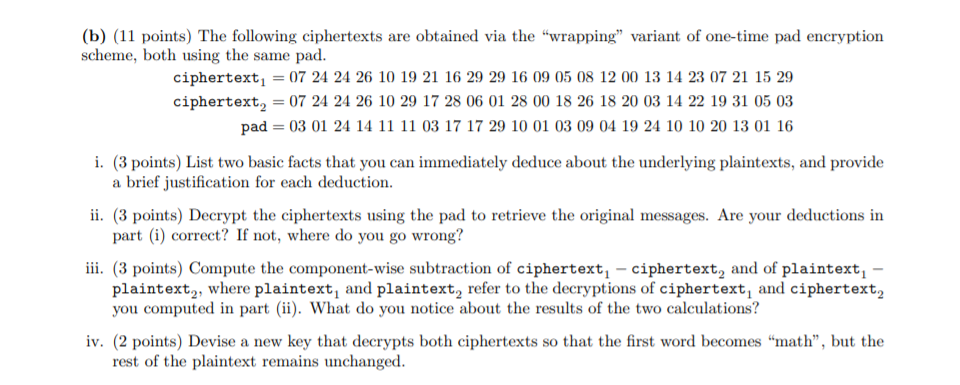

(a) (4 points) To convert from ASCII to numeric value (or vice verse) refer to this chart for part (a) to (c). a b c d e fsh 0 1 2 3 4 5 6 7 8 9 10 11 12 13 14 15 qrstuvwx 16 17 18 19 20 21 22 23 z . . ? ! space 24 25 26 27 28 29 30 31 The following ciphertexts are obtained via the "non-wrapping" variant of the one-time pad encryption scheme, both using the same pad. ciphertext; = 50 15 17 08 38 ciphertexty = 46 15 17 08 35 One ciphertext is an encryption of the plaintext "peace" while the other is an encryption of the plaintext "teach". Now i. (2 points) Determine which is which ii. (2 points) Justify your answer. (b) (11 points) The following ciphertexts are obtained via the "wrapping" variant of one-time pad encryption scheme, both using the same pad. ciphertext, = 07 24 24 26 10 19 21 16 29 29 16 09 05 08 12 00 13 14 23 07 21 15 29 ciphertext, = 07 24 24 26 10 29 17 28 06 01 28 00 18 26 18 20 03 14 22 19 31 05 03 pad = 03 01 24 14 11 11 03 17 17 29 10 01 03 09 04 19 24 10 10 20 13 01 16 i. (3 points) List two basic facts that you can immediately deduce about the underlying plaintexts, and provide a brief justification for each deduction. ii. (3 points) Decrypt the ciphertexts using the pad to retrieve the original messages. Are your deductions in part (i) correct? If not, where do you go wrong? iii. (3 points) Compute the component-wise subtraction of ciphertext - ciphertext, and of plaintext, - plaintextz, where plaintext, and plaintext, refer to the decryptions of ciphertext, and ciphertext, you computed in part (ii). What do you notice about the results of the two calculations? iv. (2 points) Devise a new key that decrypts both ciphertexts so that the first word becomes "math", but the rest of the plaintext remains unchanged. (b) (11 points) The following ciphertexts are obtained via the "wrapping" variant of one-time pad encryption scheme, both using the same pad. ciphertext = 07 24 24 26 10 19 21 16 29 29 16 09 05 08 12 00 13 14 23 07 21 15 29 ciphertext, = 07 24 24 26 10 29 17 28 06 01 28 00 18 26 18 20 03 14 22 19 31 05 03 pad = 03 01 24 14 11 11 03 17 17 29 10 01 03 09 04 19 24 10 10 20 13 01 16 i. (3 points List two basic facts that you can immediately deduce about the underlying plaintexts, and provide a brief justification for each deduction. ii. (3 points) Decrypt the ciphertexts using the pad to retrieve the original messages. Are your deductions in part (i) correct? If not, where do you go wrong? iii. (3 points) Compute the component-wise subtraction of ciphertext, - ciphertext, and of plaintext, - plaintext,, where plaintext, and plaintext, refer to the decryptions of ciphertext, and ciphertext, you computed in part (ii). What do you notice about the results of the two calculations? iv. (2 points) Devise a new key that decrypts both ciphertexts so that the first word becomes "math", but the rest of the plaintext remains unchanged








